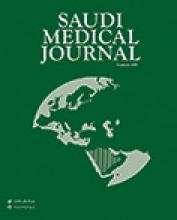Abstract
OBJECTIVE: To study the epidemiological and clinical pattern of brucellosis in children of Dhofar and to ascertain the efficacy of a pre-determined antibiotic regimen to treat the disease.
METHODS: The study was hospital based and was carried out prospectively for 3 years. All cases diagnosed to have brucellosis on clinical and serological basis were entered into the study. The epidemiological background and clinical presentations were analyzed and the clinical response to a combination of oral rifampicin and co-trimoxazole was evaluated.
RESULTS: Three hundred and seventy five cases of brucellosis were eligible for the study. Ingestion of raw milk and its products were responsible for causation of the disease in 63% of cases. Eighty three per cent had direct contact with animals mainly cattle. A minority of 4.5% denied ingestion of raw milk or coming into direct contact with animals. Fever was the most common presenting feature at 91%. We identified 2 distinct groups of presentation: Seventy per cent of those who presented with arthritis belonged to the older age group (7.34 years, standard deviation 2.64). They did not have a systemic illness. The younger age group presented with severe systemic illness associated with severe leucopenia and thrombocytopenia. The clinical response to the combination of rifampicin and co-trimoxazole was satisfactory in 90% of patients and 98% of brucella species isolated from the blood of patients were sensitive to both antibiotics used.
CONCLUSION: Ingestion of infected milk and contact with infected animals are the main causes of human brucellosis, although aerial transmission from contaminated environmental soil could not be excluded. The main clinical presentation of brucellosis in children is fever but the skeletal manifestations of the disease are significant. The hematological manifestations of the disease in endemic areas deserve special attention. The combination of oral rifampicin and co-trimoxazole for 6 weeks is adequate to treat most cases of brucellosis in children.
- Copyright: © Saudi Medical Journal
This is an open-access article distributed under the terms of the Creative Commons Attribution-Noncommercial-Share Alike 3.0 Unported, which permits unrestricted use, distribution, and reproduction in any medium, provided the original work is properly cited.






